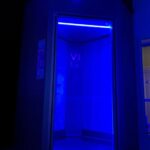
Many clients inquire before beginning a new cryotherapy venture: How do I choose whether cryosauna or cryotherapy chamber is the best option for my location?
Each buyer of cryotherapy equipment will have unique needs, generally determined by the available space in their facility, their operational preferences, and their financial capabilities. Other requirements can include assistance with setup and planning for future expansion.
When searching to buy a cryotherapy chamber or cryosauna, below is a list of inquiries you have to make of all manufacturers and suppliers. This list includes the safety features, space requirements, mobility, session quality, temperature ranges, and nitrogen system consumption rates that different nitrogen systems have to offer. Visit Nitrogen vs. Hybrid vs. Electric Cryotherapy Chambers to learn more about the possibilities for cryo chambers and the systems.
Safety Options
All cryotherapy chambers that use liquid nitrogen as cooling should come standard with a number of important safety measures, or at least have the opportunity to add more.
- Lifting the client to the proper level is called client lifting.
- Exhaust fan: After the session and while doing maintenance, it exhausts all nitrogen vapours.
- Built-in or external oxygen monitors keep track of the room’s oxygen saturation and, in certain circumstances, have the power to shut off the appliance if the level falls below a predetermined safe level.
- Emergency buttons for the operator and client provide easy access for the operator and, in some situations, the client to end the connection.
- Valve Protection: Guards against harm from inappropriate nitrogen tank pressure that might cause the machine to malfunction.
When speaking with manufacturers, be careful to ask for further details regarding these safety features.
Expectations and Claims vs. Reality
It’s critical to distinguish between assertions and reasonable expectations.
Each manufacturer has a different level of quality for cryotherapy chambers or open top cryosaunas. Manufacturers should adhere to a few basic principles, though.
Space and Room Requirements
Reality: The unit will physically need at least 12 m2 (130 sq ft), regardless of the technology or brand you choose. Particularly when bringing in extras and needs like pressurised tanks, restrooms, a storage area, or client space. The room must be between 20 and 25m2 (220 to 270 sqft) in size to fully comply with safety regulations.
Mobileness of Unit
The Cryosauna is more mobile since it is smaller or has wheels, according to the claim.
The majority of cryotherapy units, or 99 percent of them, stay locked up in the same location for years unless they are transferred as used cryotherapy equipment.
The only way to be completely mobile is to have a mobile vehicle, like an RV, that can transfer the tools and other necessities to a location where they are permanently placed. For localised cryotherapy, you might also want to think about getting a portable cryotherapy machine.
Even though the cryotherapy unit has wheels and is smaller, mobility is still mostly constrained by the unit’s overall weight and its ability to reach different sites. However, the device may be easier to install if it has these features.
Inside the customer cryo chamber, there is a comfortable temperature
Claim: “The customer cryo chamber has a consistent temperature.”
Reality: Most cryotherapy machines on the market are made to direct vapours toward the bottom half of the client’s body, which causes the lower part of the session to be quite severe while the top half of the session hardly cools. This may possibly be the cause of the unit’s alleged decreased consumption.
CRYONiQ – The device releases vapours at a certain force and enters at a higher level that reaches the shoulders and exposes the body more evenly in order to balance the temperature within the cabin. As a result of the weight of nitrogen relative to the surrounding air, nitrogen vapours will naturally gravitate to the bottom of the cabin.
WBC session temperature in LN2 based units
True temperatures should be displayed on the temperature panel, as expected.
Reality: Since liquid nitrogen boils at -196°C/-320°F, temperature displays in passenger cabins that reflect those temperatures over extended periods of time are not based on accurate data. Make careful to verify if this temperature is maintained by the machine from all manufacturers or vendors. It is important to have additional information, even if the processing unit’s outlet was used to monitor the temperature rather than the cabin’s intake or interior.
CRYONiQ – During WBC sessions, the temperature range in CRYONiQ units typically ranges from -120°C to -140°C / -180°F to -220°F. Temperatures below -150°C/-240°F (for example, -170°C/-290°F) are not permitted by our safety and operation rules. If your CRYO XCTM experiences sustained temperatures below -150°C / -240°F, the safety protocol was probably not followed. Contact Us if you need help.
Utilization of LN2 in Cryotherapy Units
Consumption of 2 to 3 litres or 1 litre for 1 kilogramme per minute is claimed.
Reality: Claiming this amount of consumption is deceptive because it’s possible that only 2 or 3 litres of LN2 will be enough to totally cool down the unit to the necessary standard for three minutes. 4 litres was mentioned as the bare minimum needed for a typical cryotherapy session with the appropriate intensity and length based on the testimonies that we have gathered from a list of venues that operated 10 different cryotherapy brands.
For any brand of open-top cryotherapy chambers, the consumption during a typical session at a temperature of -130°C / -200°F is between 4 and 10 litres. This variation in consumption will be influenced by the precool settings, scheduling, pipes & connections, intensity, and duration of the precool.
There are no short cuts in thermodynamics, thus a manufacturer is definitely faking it if they say their cryotherapy device uses less than 4 litres every session.






